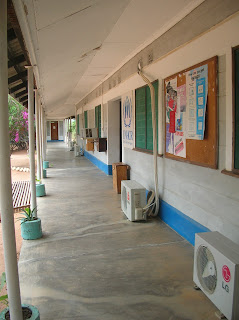 |
| Waiting to board the plane at Wilson Airport, Nairobi. |
A few weeks ago, early on a Monday morning, I boarded a plane at Nairobi’s Wilson Airport bound for my new home for the next 2 ½ months. An hour and a half later, we landed on a dusty airstrip 60 km from Somalia. I stepped off the plane and headed for the row of UN vehicles that would drive us to the UNHCR (United Nations High Commissioner for Refugees) Sub-office in Dadaab, Kenya.
In early April, my supervisor in Nairobi asked me if I was interested in doing resettlement work at a refugee camp – and not just any refugee camp, but the largest in the world. The idea immediately excited me. But, I was also hesitant to leave Nairobi; I enjoyed the work, my friends and the comfort of knowing a place well. I thought back to when I was planning my trip to Nairobi (about a year ago), and how I had hoped to have the opportunity to visit to a refugee camp while in Kenya. However, I wasn’t expecting to spend several months there. Now, four weeks into the experience, I can say that any less time than 2 ½ months would not be enough. It has been an amazing experience so far.
UNHCR’s Dadaab office serves three refugee camps in the area – Dagahaley, Hagadera and Ifo. The three camps were built to handle the influx of refugees in 1991-1992 who were fleeing the civil war in Somalia. The camps were intended to house about 90,000 refugees in total. Unfortunately, the situation in Somalia has not improved in the last 20 years, and the population of the camps is now over 350,000! Approximately 10,000 refugees are still arriving every month.
The camps are located a 10-20 drive from the UN compound. There are no paved roads in sight – the closest pavement is in Garissa, about 100 km to the west. With little rain in this part of the world, it's a dusty ride!
Driving down the road from the UN Compound to Dagahaley Refugee Camp
Each morning at 7:45, the UN vehicles leave the compound in a convey with a police escort. There have not been any recent incidents, but the proximity to Somalia and the presence of bandits make the police escort a necessary precaution. Although there is not much vehicular traffic on the roads, there are plenty of four-legged obstacles, such as cows, donkeys, goats, camels and warthogs.
My weekday mornings are spent interviewing refugees at one of the field offices in the three camps. My caseload focuses on refugees with serious medical needs, regardless of their date of arrival in Kenya. I see children brought into the office in wheelbarrows, refugees with missing limbs and albino Somalis. Albinos are particularly at risk in the camps because of the strong sun and those wanting to use albino organs for witchcraft.
Afternoons are spent back at the office in the UN compound, writing up the cases I interviewed that morning. There is a lot of work to be done, and I’m barely scratching the surface. But each day is extremely rewarding.
Driving past Ifo Refugee Camp, view of some of the homes in the camp.
The Dadaab UNHCR Sub-office is located in a compound with several other relief agencies. It is the largest of the agencies in the compound, with its own gym, tennis court, residences, offices, bar and dining hall. Below are a few pictures from inside the UNHCR compound.
View from my office into the resettlement/protection section.
The gym - inside view.
The gym - outside view.
 My home – the left half.
My home – the left half.
A "street” in the UN compound. It’s recommended that you stay on the paths so that you don’t encounter camel spiders, scorpions or spitting cobras!
The mess/cafeteria.























